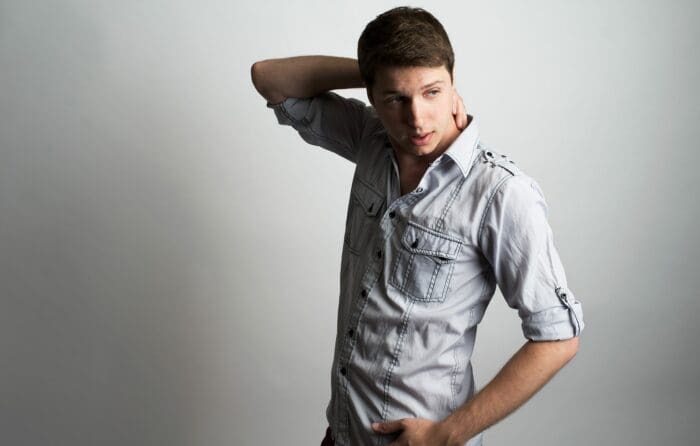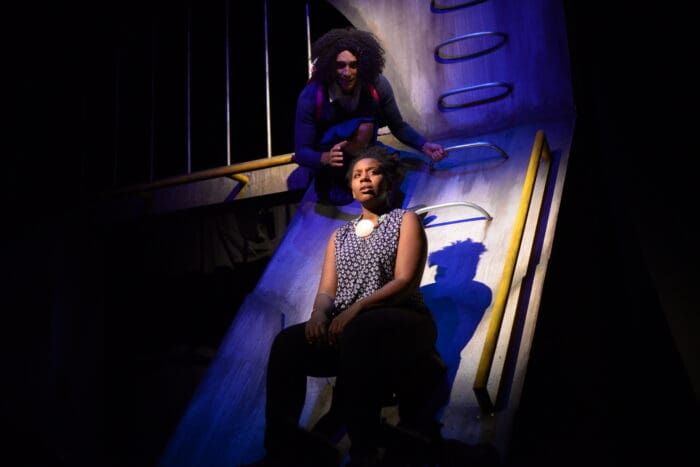 Before we announce the winners of the 2016 MyTheatre Awards, we’re proud to present our annual Nominee Interview Series.
Before we announce the winners of the 2016 MyTheatre Awards, we’re proud to present our annual Nominee Interview Series.
Ryerson grad Joe Pagnan’s Outstanding Set & Costume Design-nominated work on Obsidian Theatre’s arresting production of Venus’ Daughter at the Theatre Centre was some of the most visually impactful of the year, incorporating elements of the practical and the fantastical. His thoughtful, poetic, and verbose interview is similarly affecting.
 Do you remember your first experience with theatre?
Do you remember your first experience with theatre?
There were two moments that stand out most, and I suppose they are two separate qualities of experiencing something. There is the one where you are struck apart, and another where you sort of first step over that foundation line of what theatre is for you. And I think every creator, at least in live performance, has those two separate experiences. The first moment where you recognize your place as audience, for me, was the Lion King. And of course there was a collective eye roll throughout the land. But seriously. I went to the Lion King very shortly after my father passed away, with my step mom, who hated Toronto; she decided to do this for me, it was important. We took the train from Guelph, arrived at Union station, and immediately my neck was craned. I had never seen a sky scraper before. So it was a day of overwhelming sense. My brain was primed to see everything as if I’d never see it again. So this is peppered with a few milestones there for my family life and relationship with my mother. Needless to say, paternal themes run strong in the show. I was so moved by the scale, visual world, that I just wanted my dad to be able to have seen something like this. Not even with me. But to have had a chance to see it. So that was when, at that wise old age of 9, I recognized the power that theatre has as icon and as therapy. But, as stories go, that didn’t necessarily keep me in it
The second moment where one becomes part of the tribe, was yet again, my next trip to Toronto. This time with a friend of mine who went often. It was in a theatre that no longer exists, to me it felt like it was under the expressway. I was recently out of the closet, and, I think the best visual to go with my emotional state would be those arctic birds that swan dive into the ocean as there first thing they do. I was awkwardly in love with everything, and too scared to know what to do about it. Of course, the show ended up being about that. It was by a collective made to work on that particular piece, called Wax Wing Productions. Based on Icarus and the different stories of people falling and what emotional impact that has. It was tactile, visceral, movement based, dance theatre, with eight lights, and the audience, by virtue of the space, had to sit on pews. This is when I experienced (not just saw) theatre in its most sincere attitude. And it was talking after the show with the collective that I began to feel that the tribe I would want to be a part of was theatre.
What was the first thing you ever designed?
The first piece I designed would be The Birds, definitely. It was a staging of Hitchcock’s film penned by Ed McBain. I think it was my first monochromatic set design as well, it all focused around the muralist working on a plastic drop canvas and ten battered chairs representing the human characters. Above the space were some thirty or so bird cages rigged to animate, collapse and track. We used light through those cages to create most of the horror. It was the first time I tried to strip away realism; I never went back.
How did you get involved with Venus’ Daughter?
To this day I have no idea how I became on Obsidian’s hit list, but I received a call out of the blue from their General Manager at the time; they had seen some of my work and thought I might be fun to play with. They sent a manuscript my way to give a read. So a few day later, having read Meghan Swaby’s most recent draft, I rang up Philip Akin and just said, “It is impossible, I love it, let’s do it!” How exactly I got involved, I leave to Philip and Tania for the myth, but never a day goes by I do not reflect on the beautiful lessons I learnt from Obsidian Theatre.
How much guidance did director Philip Akin and writer Meghan Swaby give you when you were developing the look of the show?
Quite a lot in the initial stages. I sat with Meghan and interviewed her on the script, where it came from, the usual suspects. Followed up with Philip about his hopes dreams and desires, you know easy questions, right? I spoke about my experiences or what for me the text dredged up from the depths. With stage directions such as “She opens her mouth and eats the theatre” it was a beautiful poetic, enigmatic world. I needed to get to know Mama Wata. Philip and Meghan really helped me understand their lived experiences, and the legacies this production was calling on. It was Meghan talking about her inspiration for the piece: a Nine Night she was at where this party seemed to come out of the pavement. It ended up giving us the monolithic symbol of the urban dam

The play deals with the past and the present in both fantasy and reality, how did you marry all of those elements in the design?
For me, the environment became a reflection on generational amnesia, and a cry out against our urbanization paving over our waterways and heritage. It was histories being lost to concrete pillars, where the oral tradition there shifts to graffiti, to the rhythm of the text. What space do we claim to sift through the tradition when the ground the tradition comes from is no longer your own?
Mama Wata was the catalyst for this one. She was there on the set hiding in the graffiti on the floor. Some people recognized her, others didn’t. I’ll speak later about my artistic statement, but I am deeply influenced by our organic world and the decay, or erosion we are experiencing. How we as broken heroes exist still in the shifting landscape. I had been reading up on the folklore of La Llorona and I was reading a poem that brought Swaby’s world into focus for me. it’s a poem written by Victoria Moreno, a brave voice for Chicana culture. Moreno posited on the modern La Llorona, crying for her children along floodways of the city. How stunned would she be to be met with a concrete wall? This of course was reflecting on the urbanization of Mexico City and the cement rivers claiming so many lost children; which was a parallel to Cortez. Which was a parallel to Professor Dunlop. But it struck a chord. How can our heritage find us, or how can we find it, if we are so quick to dismantle our histories? So we deal with amnesia, all of us. This work is about seeking. The folklore, my experiences playing down by a water dam in Guelph ON, and my father, who I mentioned before having worked in water works, was how I became present. What messages of my heritage had I censured? A dash of graffiti, lost language, and legacy. We can pull back the drape over our past where fantasy and history co-mingle. Absolutely anything can happen on that plane.
What were some of the technical challenges of executing that design?
As much as I insisted we pave the space and flood it, I just don’t think it was in the cards. The theatre centre is a gorgeous modern facility. I think that was the biggest challenge at first, how does this world fit in such a quality space. There was a series of impossible ideas coming off the design and direction desks. Solving ways to break through cement to red clay, to slice cement with a scalpel, or being able to bathe in a buried river were some of those challenges. Dirt and water are dynamic images, because they are both destructive forces. Having them present in a theatre required a great deal of planning.
I think Philip had the hardest technical performance challenge because of the final layout of the show. The only way this symbol could fit in the theatre centre, and be impactful, situated it in such a way that the performers became annexed from back stage.
Simulating this cement structure, and making it sturdy enough to be occupied became a team effort. This environment only works in its abstracted reality when it can be manipulated and physicalized, as it would exist apart. I spoke with Philip very early on, and we reached out to the cast to let them know parkour and BMX might be asked of them, and I worked with our exceptional PM, and build teams to make this a safe environment we could really let loose in.
Were you pleased with how the design worked in practice?
Absolutely. There were challenges, and that is visual storytelling exists within multiple structures, in this case this story, on the cement set, within the theatre centre. Some aspects, if I were to return to it, certainly would change, but mostly because I have changed in this year following. My viewpoints have shifted and I think new insights always continue to develop, especially on new Canadian work. I, and how I would read the story, is influenced by changing global currents. The piece at that time was right. The palettes were strong. When you can bring items that link into an audience and the performers’ own memory bank, suddenly lived heritage and our written history coexists. That’s when the world really expands beyond your control, Venus’ Daughter gave the right anchor points, and I hope the audience felt welcomed into our world.
What was your favourite moment in that production?
Ah, so many. I think, in all honesty my favourite is when Sarah Baartman is displayed on the wall. It was … cutting. Seeing the scalpels slice and thunk into the floor, with this powerful woman on the dissection table. It was cold, sharp, precise. Her monologue about her body tensing, and getting ready to spit. We saw the Turtles power and pride swell in Baartman. Being challenged to deliver that powerful monologue while in a compromising physical position like that, was sobering. It was a moment for me where the challenge of the set, physically and emotionally took a place of discomfort in the muscle. It only made sense that she someday, would be able to open the cage, and shattered the stone, her oppressor, in legacy.
What are you doing now/ what’s your next project?
I am currently working on a new musical with Sheridan College called Senza Luce that is focused on a small mountain town living in complete darkness. They’ve found this, once upon a time, utopia; however without the sun, they suffer. It all pivots on this young boy armed with his father’s journal who wants to bring the town into the light. Stories emphasizing our changing environment, and our political responsibilities to science and discovery, are important right now; especially if we can weave in a sincere and sensitive human element. I’m excited to see this coming year of theatre and dance; I think we are in for a very strong year of design and new, brave, Canadian theatre.
Do you have anything you’d like to add?
I never know what to add. I think we are living right now in a time of great ecological change, and I think the human experience of our environments is something we need to clock. Our realities are defined by numerous environmental impacts. We often are defined by the spaces we occupy. In our current political and environmental state of erosion or let’s say “change”, we have a visible, and very present, narrative of displacement. Maybe in an act of creation, we are beginning to define space electronically because of this. Though time, or the elasticity of it, is becoming difficult to grasp. I hope more people tell their stories whatever means they need to – oral, visually, digitally. And I wish the accessibility remain.. But I also fear us losing access to ephemeral art practices; I think they best reflect our ecological reality. Seeking a place for us together in these shifting landscapes, like I mentioned before, is important. It begins the discussion of a global identity as opposed to a national. Technology is catalyst to the sharing of our stories but it also may limit their space of breathing. I’m interested in seeing how technology, and the performing arts, finds the common ground. I think Canada is situated perfectly at a precarious time, to explore this.
Thanks for this interview, it definitely is reciprocal; I learned a lot answering these questions.
